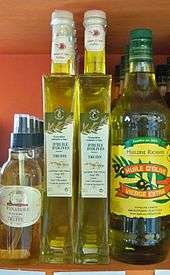Truffle oil

Truffle oil is a modern culinary ingredient used to impart the flavor and aroma of truffles to a dish. The ingredient is commonly used as a finishing oil[1] in a variety of dishes, including truffle fries, pasta dishes, pizzas, and puréed foods such as mashed potatoes and deviled eggs.[2] Truffle oil is available in all seasons and relatively steady in price. It is popular with chefs, home cooks, and diners because it is significantly less expensive than fresh truffles. This has also led to a market growth in the product and an increase in the availability of truffle-flavored foods.
Truffle oil is controversial as a flavoring ingredient, as some truffle oil is artificially produced and may lack the complex flavors and aromas of fresh truffles.
Composition
| Tuber melanosporum aroma compounds | |
|---|---|
| dimethylsulfide | 7.5% |
| acetaldehyde | 4.5% |
| 2-methylpropanal | 5% |
| 2-methylbutanal | 4% |
| ethanol | 27% |
| 2-methyl-1-propanol | 21% |
| 2-methyl-1-butanol | 17% |
| acetone | 8% |
| 2-butanone | 2.5% |
| 1-propanol | 2% |
| Source:Truffe et trufficulture[3] | |
Truffle oil can be produced using any oil, like the flavorless canola or grapeseed oils, however they are often made with olive oil.
Some truffle oils are made with truffle residues incurred during collection or preparation for sale. Many truffle oils sold in retail markets are not made from truffles,[1] but instead use manufactured aromatic compounds including 2,4-dithiapentane (a prominent aroma active compound found in truffles) with an oil base. There are no regulations regarding the labeling of 2,4-dithiapentane, and it can legally be called truffle aroma, truffle flavor, truffle concentrate or other similar terms even though it is not extracted from truffles. In the United States, the ingredient may use the modifiers "organic" or "natural" as long as the components meet the federal requirements for those terms. Truffle oils range from clear to cloudy, and yellow to green, depending on the base oil used. Some include a piece of truffle in the bottle.[2] These pieces can be from any of over 200 different truffle species, and may be listed as "black truffle" or "white truffle" even if not one of prized culinary varietals such as the black Perigord or white Alba truffle.
History
Preserved truffles have a long history of use, as fresh truffles are seasonal, and require proper storage and careful use in order to maintain their rich flavors.[4](p21) Artificial truffle oils have been produced since the 1980s, around when truffles became internationally popular.[5]
In foraging
Truffle oil is frequently used as a bait for truffle-hunting dogs and pigs. Modern Italians often use a strufion, a ball of rags scented with truffle oil.[4](p87) Truffle oil has been used for this purpose since at least 1756, made by boiling truffles in olive oil and given to hunting dogs.[6]
Reception
Truffle oil has a mixed reception among chefs and food critics. In a New York Times article, Daniel Patterson wrote, "[truffle oil's] one-dimensional flavor is also changing common understanding of how a truffle should taste."[7] Anthony Bourdain said, "Let it be stated here, unto forever and eternity, truffle oil is not food."[8] He is also known for describing it as the "tomato ketchup of the middle class".[4](p21) Celebrity chef Martha Stewart expressed her dislike of truffle oil in a 2014 post on Reddit, stating "I think truffle oil is one of the few ingredients that doesn't belong in anyone's kitchen. It's ruinous of most recipes."[9] Restaurateur Joe Bastianich said, "It's made by perfumists. It's garbage olive oil with perfume added to it, and it's very difficult to digest. It's bad for you. It's bad for New Yorkers. It's bad for the American people. So, stop it."[10]
In 2009, celebrity chef Gordon Ramsay referred to truffle oil as "a chef's dream",[11] yet in 2011 on the show MasterChef he called it "one of the most pungent, ridiculous ingredients ever known to [a] chef."[12]
Gareth Renowden, truffle grower and author of The Truffle Book, wrote that "truffle oil and the many truffle-flavored products that have come on to the market in the last few years are not necessarily bad, but they can lead to unrealistic expectations when you encounter the real thing. They offer a consistent experience, one you can guarantee to taste in the dish...they offer a simplified picture, a sort of cartoon version - bright and colourful but ultimately false".[4](p21)
References
| Wikimedia Commons has media related to Truffle oil. |
- 1 2 "Truffle Oil". Bon Appetit. November 27, 2007. Retrieved September 3, 2016.
- 1 2 Koenig, Leah (March 9, 2009). "Truffle Oil". Saveur. Retrieved September 3, 2016.
- ↑ JM Olivier, P. Sourzat, JC Savignac (2002). Truffe et trufficulture. Editions Fanlac. ISBN 978-2865772285.
- 1 2 3 4 Renowden, Gareth (2005). The Truffle Book. New Zealand: Limestone Hills Publishing. ISBN 0-473-10242-0. Retrieved September 3, 2016.
- ↑ Mayyasi, Alex (July 30, 2014). "The Truffle Oil Shuffle". Priceonomics. Retrieved September 3, 2016.
- ↑ Keyßler, Johann Georg (1756). Travels Through Germany... 1 (2 ed.). London: A. Linde. Retrieved September 3, 2016.
- ↑ Patterson, Daniel (May 16, 2007). "Hocus-Pocus, and a Beaker of Truffles". The New York Times. Retrieved September 3, 2016.
- ↑ "Guilty Pleasures". The Taste. Season 2, Episode 3. January 16, 2014. American Broadcasting Company.
- ↑ "I'm Martha Stewart. Ask me almost anything! It's a good thing.". Reddit. March 6, 2014. Retrieved September 3, 2016.
- ↑ "Eataly Founder Joe Bastianich Tells Us How He Really Feels About Truffle Oil". Huffington Post. October 31, 2014. Retrieved September 3, 2016.
- ↑ "Gordon Ramsay - Truffled cream cheese". YouTube. October 17, 2009. Retrieved September 3, 2016.
- ↑ Lynch, Rene (June 7, 2011). "Chef Gordon Ramsay on the one ingredient you should NOT have in your pantry". Daily Dish. Los Angeles Times. Retrieved September 3, 2016.